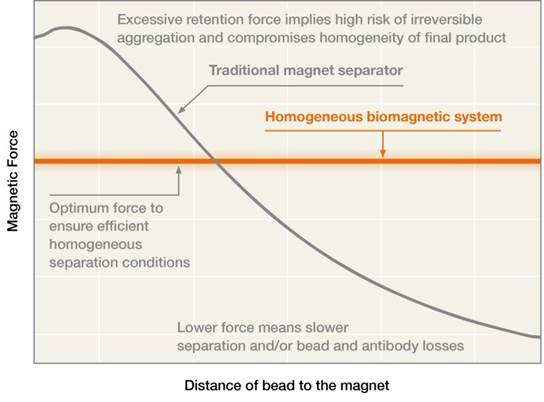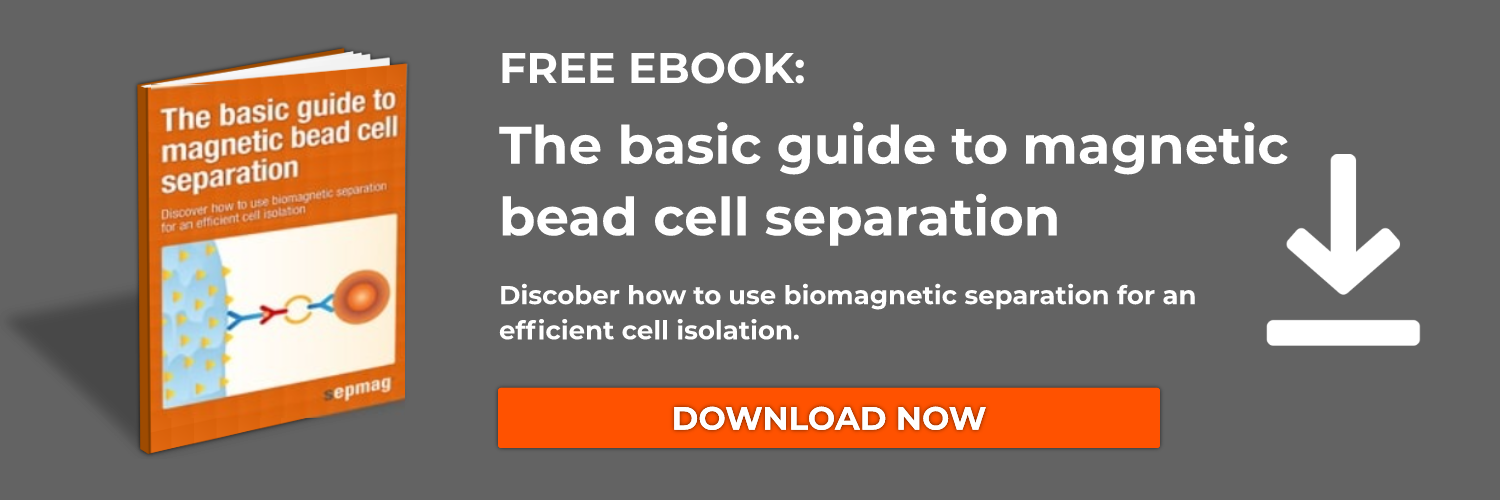Use of magnetic beads provides an efficient and innovative method of harnessing magnetic separation processes to non-magnetic, cellular targets of biological origin. When beads are attached, the ensemble of the cells and beads becomes a magnetizable object.
The magnetic beads are superparamagnetic and will therefore display magnetic properties when a magnetic field is applied, but will retain no residual magnetism after the magnetic field is removed. Depending on the concentration and size of the beads, they can be induced to behave independently or to cluster together to form aggregates.
Cooperative magnetophoresis
If the magnetic field is high enough to saturate the beads and the resultant magnetic moment big enough, they will interact with each other to form chains. The aggregates will not only be less susceptible to drag forces, but will also have a higher magnetic moment. As a result, their movement will be accelerated, optimizing their collective power. The size of the magnetic force necessary to induce the beads to form aggregates is dependent on their diameter, and increases as the diameter of the beads decreases.
Cooperative magnetophoresis, the phenomenon in which particles aggregate to form clusters during a separation process, shortens the time necessary to complete a separation protocol by orders of magnitude. In contrast, non-cooperative magnetophoresis, in which the beads do not aggregate but rather behave as individual particles, is a slower separation regime. Whether or not the beads aggregate is dependent on the concentration, size, and magnetic content of the particles. The relationship of these factors to the beads’ aggregating behavior in a magnetic field is mathematically defined. As such, it is possible to increase the speed and efficiency of a protocol by calculating the parameters required to induce clustering. The key is to induce clustering, while preventing uncontrolled and irreversible aggregation.
In cases where the magnetic force is inhomogenous, the force experienced by the beads will vary depending on the bead’s distance from the magnet. Beads that are far away will be unsaturated and thus have a small magnetic moment. This will make clustering less likely, and the beads will be more susceptible to drag and other forces, slowing their rate of motion and increasing the timescale of the separation.
The parameters on which a magnetic field depends are more difficult to define in inhomogenous systems. As a result, these processes are more difficult to scale up. Increasing the volume of a process also increases the distance that a bead has to travel, and its distance in relation to the magnet. Thus the forces necessary to maintain a reasonable timescale increase as the sample volume increases.
In homogenous systems, the magnetic force does not vary. All the beads in the system are subject to the same force regardless of their position in relation to the magnet, and therefore move at the same speed. The timescale required for a process is a function of the diameter of the separation vessel.
This article explains how magnetic fealds are applied during magnetic activated cell sorting processes. If you are interested in knowing more about this process, download our free basic guide to magnetic bead cell sorting:
Electromagnet or Permanent Magnets considerations
The decision to use Permanent Magnets or Electromagnets will be based on a number of factors, including the sample volume, process goals, and system methodology. Each type of magnet has characteristics that will make them better suited to a particular process. The two classical options are electromagnets and permanent magnets.
Electromagnets are generally more amenable to smaller volumes. The heat generated as a result of resistance is small in these cases, and can be dissipated easily. Larger volumes require larger electromagnets, which can generate excessive amounts of resistive heat, requiring costly cooling systems and power supply maintenance.
Unlike electromagnets, permanent magnets aren’t powered by electricity and don’t require cooling systems or maintenance. As such, they are more suitable for larger volumes. With large, open permanent magnets, precautions must be taken to avoid stray fields that can be generated, constituting a safety hazard, but modern advanced designs keep safety distances short and the resulting footprint small. Also, unlike the case with an electromagnet where the magnetic field will depend on parameters such as current (and therefore the power supply precision and stability), permanent magnets keep the magnetic field constant during tens of years.
The characteristics inherent to permanent magnets and electromagnets must be taken into account when designing a protocol. There are benefits and drawbacks intrinsic to each type. Ultimately, however, the methodology will be informed by the goals and variables specific to each process.
Related articles:





